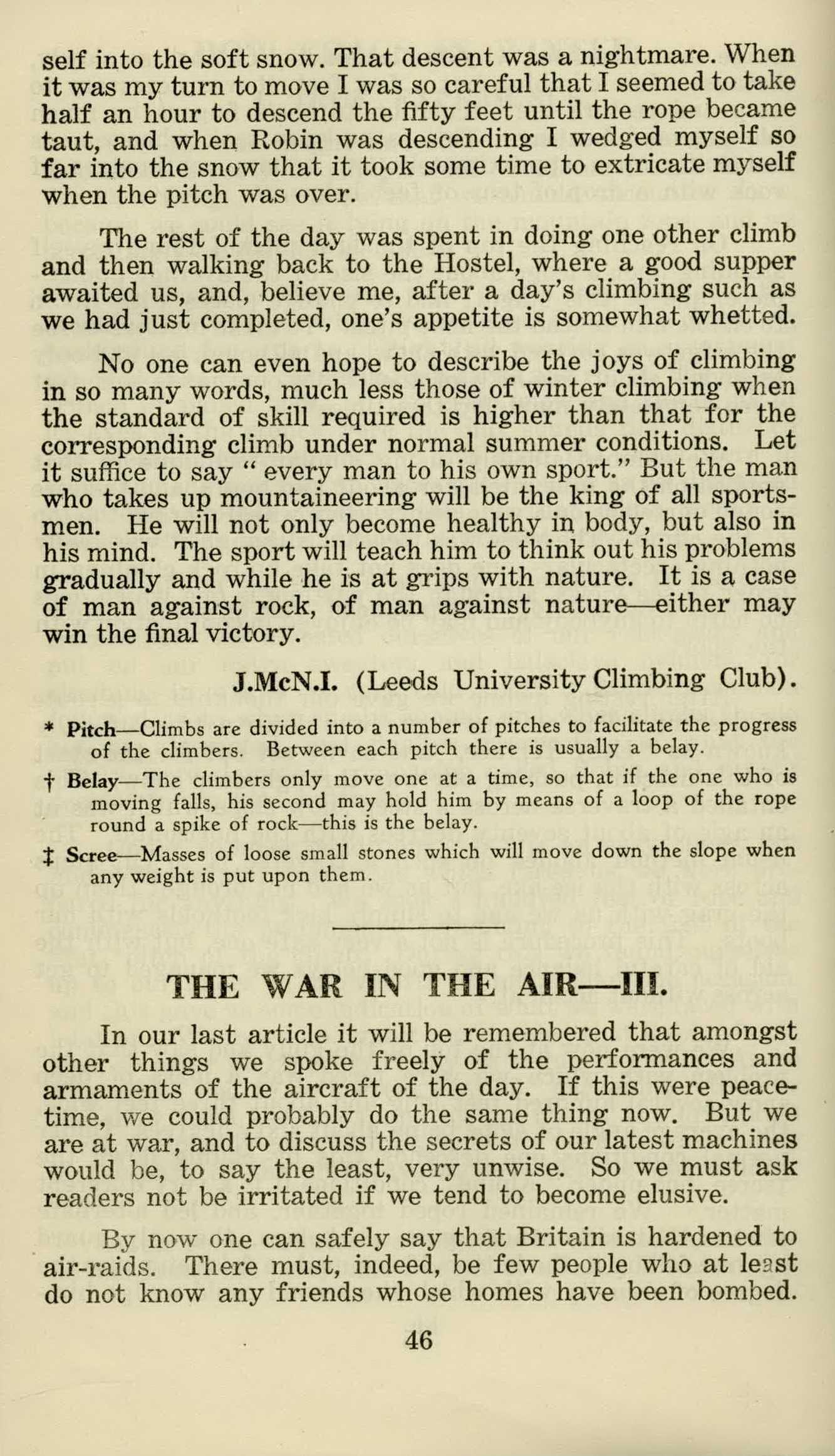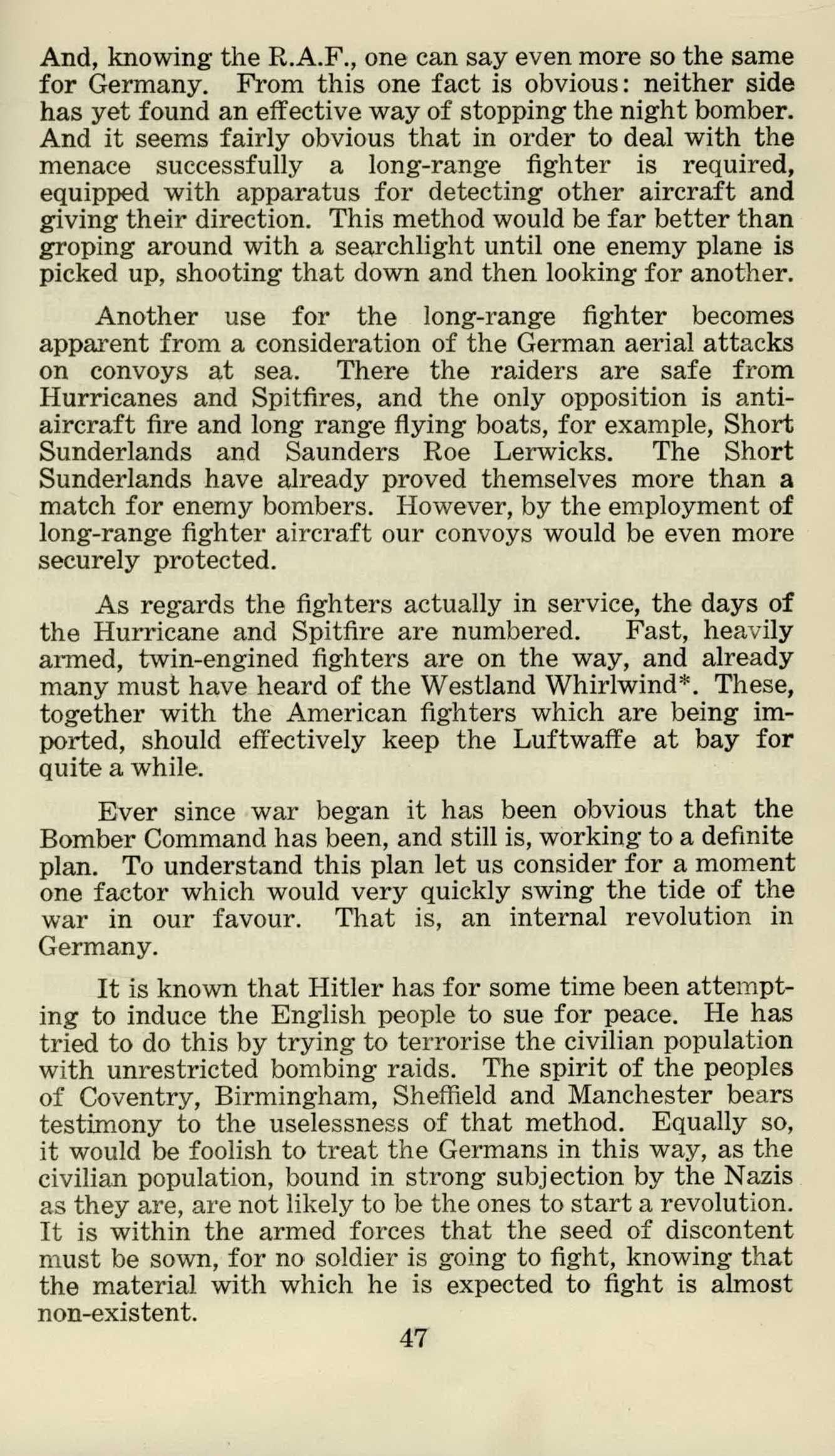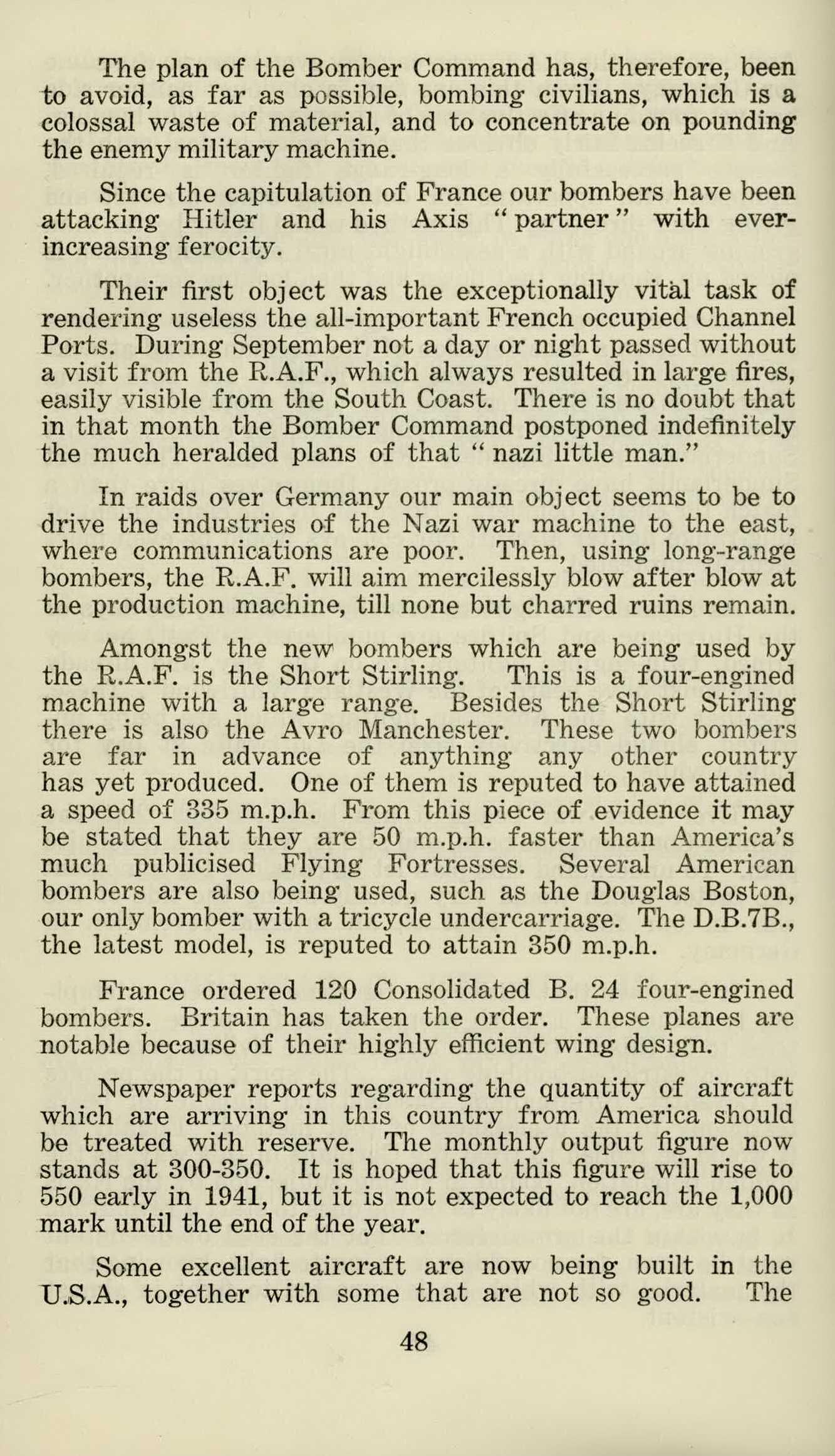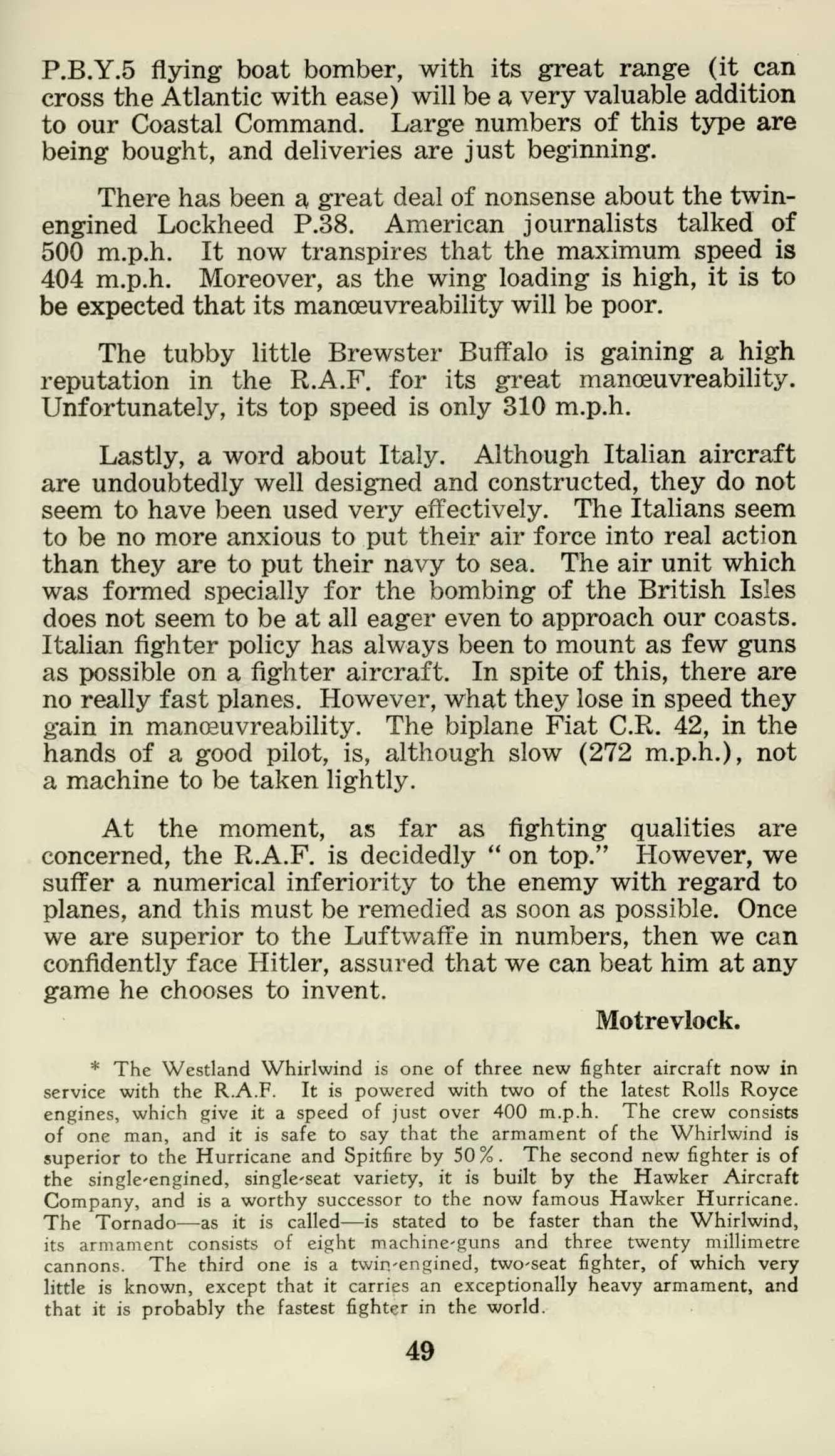
8 minute read
The War in the Air—III
from Jan 1941
by StPetersYork
self into the soft snow. That descent was a nightmare. When it was my turn to move I was so careful that I seemed to take half an hour to descend the fifty feet until the rope became taut, and when Robin was descending I wedged myself so far into the snow that it took some time to extricate myself when the pitch was over.
The rest of the day was spent in doing one other climb and then walking back to the Hostel, where a good supper awaited us, and, believe me, after a day's climbing such as we had just completed, one's appetite is somewhat whetted.
No one can even hope to describe the joys of climbing in so many words, much less those of winter climbing when the standard of skill required is higher than that for the corresponding climb under normal summer conditions. Let it suffice to say " every man to his own sport." But the man who takes up mountaineering will be the king of all sportsmen. He will not only become healthy in body, but also in his mind. The sport will teach him to think out his problems gradually and while he is at grips with nature. It is a case of man against rock, of man against nature—either may win the final victory. J.McN.I. (Leeds University Climbing Club).
* Pitch—Climbs are divided into a number of pitches to facilitate the progress of the climbers. Between each pitch there is usually a belay. -I. Belay—The climbers only move one at a time, so that if the one who is moving falls, his second may hold him by means of a loop of the rope round a spike of rock—this is the belay.
Scree—Masses of loose small stones which will move down the slope when any weight is put upon them.
THE WAR IN THE AIR-HI.
In our last article it will be remembered that amongst other things we spoke freely of the performances and armaments of the aircraft of the day. If this were peacetime, we could probably do the same thing now. But we are at war, and to discuss the secrets of our latest machines would be, to say the least, very unwise. So we must ask readers not be irritated if we tend to become elusive.
By now one can safely say that Britain is hardened to air-raids. There must, indeed, be few people who at least do not know any friends whose homes have been bombed. 46
And, knowing the R.A.F., one can say even more so the same for Germany. From this one fact is obvious : neither side has yet found an effective way of stopping the night bomber. And it seems fairly obvious that in order to deal with the menace successfully a long-range fighter is required, equipped with apparatus for detecting other aircraft and giving their direction. This method would be far better than groping around with a searchlight until one enemy plane is picked up, shooting that down and then looking for another.
Another use for the long-range fighter becomes apparent from a consideration of the German aerial attacks on convoys at sea. There the raiders are safe from Hurricanes and Spitfires, and the only opposition is antiaircraft fire and long range flying boats, for example, Short Sunderlands and Saunders Roe Lerwicks. The Short Sunderlands have already proved themselves more than a match for enemy bombers. However, by the employment of long-range fighter aircraft our convoys would be even more securely protected.
As regards the fighters actually in service, the days of the Hurricane and Spitfire are numbered. Fast, heavily armed, twin-engined fighters are on the way, and already many must have heard of the Westland Whirlwind*. These, together with the American fighters which are being imported, should effectively keep the Luftwaffe at bay for quite a while.
Ever since war began it has been obvious that the Bomber Command has been, and still is, working to a definite plan. To understand this plan let us consider for a moment one factor which would very quickly swing the tide of the war in our favour. That is, an internal revolution in Germany.
It is known that Hitler has for some time been attempting to induce the English people to sue for peace. He has tried to do this by trying to terrorise the civilian population with unrestricted bombing raids. The spirit of the peoples of Coventry, Birmingham, Sheffield and Manchester bears testimony to the uselessness of that method. Equally so, it would be foolish to treat the Germans in this way, as the civilian population, bound in strong subjection by the Nazis as they are, are not likely to be the ones to start a revolution. It is within the armed forces that the seed of discontent must be sown, for no soldier is going to fight, knowing that the material with which he is expected to fight is almost non-existent.

47
The plan of the Bomber Command has, therefore, been to avoid, as far as possible, bombing civilians, which is a colossal waste of material, and to concentrate on pounding the enemy military machine.
Since the capitulation of France our bombers have been attacking Hitler and his Axis " partner " with everincreasing ferocity.
Their first object was the exceptionally vital task of rendering useless the all-important French occupied Channel Ports. During September not a day or night passed without a visit from the R.A.F., which always resulted in large fires, easily visible from the South Coast. There is no doubt that in that month the Bomber Command postponed indefinitely the much heralded plans of that " nazi little man."
In raids over Germany our main object seems to be to drive the industries of the Nazi war machine to the east, where communications are poor. Then, using long-range bombers, the R.A.F. will aim mercilessly blow after blow at the production machine, till none but charred ruins remain.
Amongst the new bombers which are being used by the R.A.F. is the Short Stirling. This is a four-engined machine with a large range. Besides the Short Stirling there is also the Avro Manchester. These two bombers are far in advance of anything any other country has yet produced. One of them is reputed to have attained a speed of 335 m.p.h. From this piece of evidence it may be stated that they are 50 m.p.h. faster than America's much publicised Flying Fortresses. Several American bombers are also being used, such as the Douglas Boston, our only bomber with a tricycle undercarriage. The D.B.7B., the latest model, is reputed to attain 350 m.p.h.
France ordered 120 Consolidated B. 24 four-engined bombers. Britain has taken the order. These planes are notable because of their highly efficient wing design.
Newspaper reports regarding the quantity of aircraft which are arriving in this country from America should be treated with reserve. The monthly output figure now stands at 300-350. It is hoped that this figure will rise to 550 early in 1941, but it is not expected to reach the 1,000 mark until the end of the year.
Some excellent aircraft are now being built in the U.S.A., together with some that are not so good. The 48

P.B.Y.5 flying boat bomber, with its great range (it can cross the Atlantic with ease) will be a very valuable addition to our Coastal Command. Large numbers of this type are being bought, and deliveries are just beginning.
There has been a great deal of nonsense about the twinengined Lockheed P.38. American journalists talked of 500 m.p.h. It now transpires that the maximum speed is 404 m.p.h. Moreover, as the wing loading is high, it is to be expected that its manceuvreability will be poor.
The tubby little Brewster Buffalo is gaining a high reputation in the R.A.F. for its great manceuvreability. Unfortunately, its top speed is only 310 m.p.h.
Lastly, a word about Italy. Although Italian aircraft are undoubtedly well designed and constructed, they do not seem to have been used very effectively. The Italians seem to be no more anxious to put their air force into real action than they are to put their navy to sea. The air unit which was formed specially for the bombing of the British Isles does not seem to be at all eager even to approach our coasts. Italian fighter policy has always been to mount as few guns as possible on a fighter aircraft. In spite of this, there are no really fast planes. However, what they lose in speed they gain in manceuvreability. The biplane Fiat C.R. 42, in the hands of a good pilot, is, although slow (272 m.p.h.), not a machine to be taken lightly.
At the moment, as far as fighting qualities are concerned, the R.A.F. is decidedly " on top." However, we suffer a numerical inferiority to the enemy with regard to planes, and this must be remedied as soon as possible. Once we are superior to the Luftwaffe in numbers, then we can confidently face Hitler, assured that we can beat him at any game he chooses to invent.

Motrevlock.
* The Westland Whirlwind is one of three new fighter aircraft now in service with the R.A.F. It is powered with two of the latest Rolls Royce engines, which give it a speed of just over 400 m.p.h. The crew consists of one man, and it is safe to say that the armament of the Whirlwind is superior to the Hurricane and Spitfire by 50%. The second new fighter is of the single-engined, single-seat variety, it is built by the Hawker Aircraft Company, and is a worthy successor to the now famous Hawker Hurricane. The Tornado—as it is called—is stated to be faster than the Whirlwind, its armament consists of eight machine-guns and three twenty millimetre cannons. The third one is a twin-engined, two-seat fighter, of which very little is known, except that it carries an exceptionally heavy armament, and that it is probably the fastest fighter in the world.










